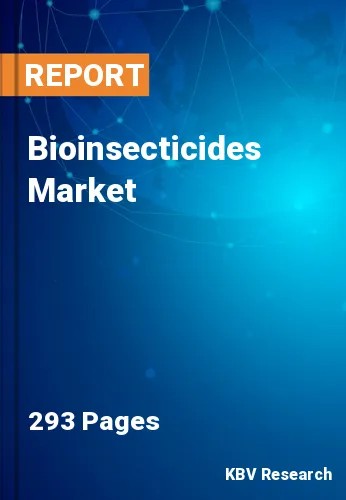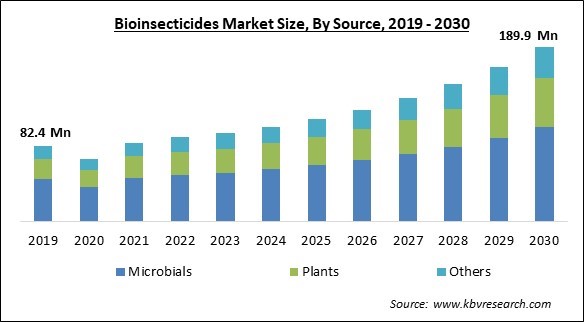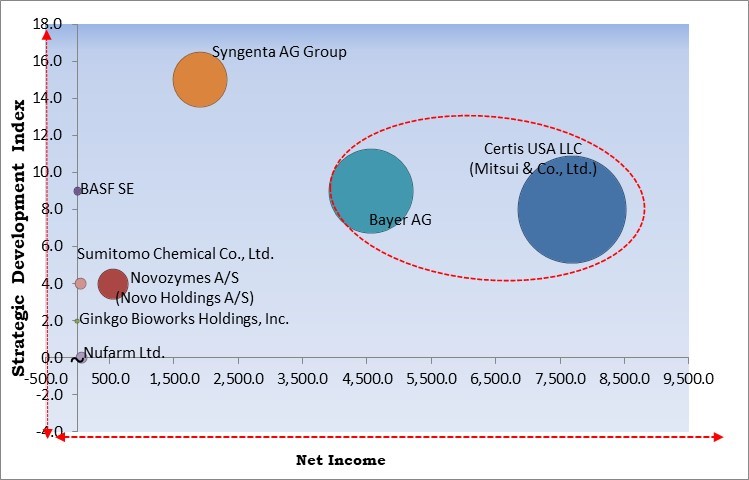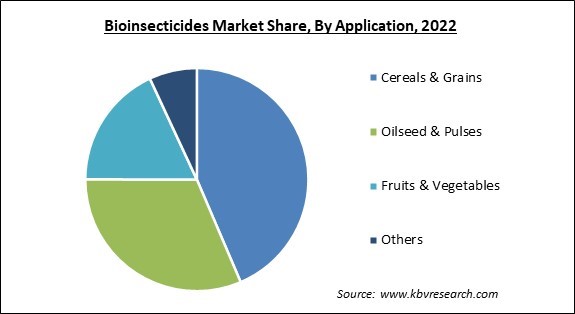
The Global Bioinsecticides Market size is expected to reach $189.9 million by 2030, rising at a market growth of 10.2% CAGR during the forecast period.In the year 2022, the market attained a volume of 1,918.3 Kilo Litres, experiencing a growth of 2.2% (2019-2022).
Due to the expanding demand for eco-friendly and sustainable pest management solutions. Hence, the North America region is poised to acquire more than 30% share of the market by 2030. In addition, North America is home to several companies specializing in producing and developing bioinsecticides. These businesses are continually developing new and improved products that are more effective and simpler.

The major strategies followed by the market participants are Product Launches as the key developmental strategy to keep pace with the changing demands of end users. For instance, In March, 2021, Bayer launched Vynyty Citrus, the biological and pheromone-based crop protection product to control pests on citrus farms. In May, 2023, BASF announced the launch of Cimegra, an insecticide providing control of prevalent and difficult-to-control chewing insects.
Based on the Analysis presented in the KBV Cardinal matrix; Bayer AG and Certis USA LLC (Mitsui & Co., Ltd.) are the forerunners in the Market. In February, 2023, Certis Biologicals rolled out SoilGard, a microbial fungicide consisting of an easily usable granular formulation. Companies such as Syngenta AG Group, BASF SE and Sumitomo Chemical Co., Ltd. are some of the key innovators in Market.

The increase in pest resurgence due to resistance and ecological imbalances has created a need for sustainable and effective pest management solutions. Bioinsecticides, with their environmentally friendly and targeted approach, offer a valuable tool for mitigating the challenges posed by pest resurgence in agriculture. The increase in pest resurgence is indeed one of the driving factors behind the growth of bioinsecticides. By addressing the root causes of pest resurgence, such as the disruption of ecosystems through chemical pesticide use, bioinsecticides contribute to the long-term sustainability of agricultural systems. Hence, all these factors are propelling the growth of the market.
The adoption of organic food has been a growing trend over the past several years, driven by various factors, including health concerns, environmental awareness, and changing consumer preferences. Organic food is produced using methods that avoid synthetic pesticides, chemical fertilizers, genetically modified organisms (GMOs), and certain other additives or processing methods. Organic food is often certified by recognized organizations that ensure adherence to specific production standards. This certification provides consumers with confidence in the authenticity of organic claims. Bioinsecticides are emerging as an important component of organic production. Therefore, as the demand for organic products increases, the demand will also increase.
The relatively short shelf life of bioinsecticides is one of the challenges associated with these products. Bioinsecticides, which are derived from living organisms or natural compounds, can have a limited lifespan compared to some synthetic chemical pesticides. When the target pest is absent, the bioinsecticide may not have a purpose, reducing its effective life span. Also, bioinsecticides' relatively short shelf life can impact their commercial viability, as it may increase the costs associated with production, storage, and distribution. Hence, the short life span of bioinsecticides along with the factors mentioned above can hamper the growth of the market.
On the basis of application, the market is divided into cereals & grains, oilseeds & pulses, fruits & vegetables, and others. In 2022, the cereals and grains segment registered the highest revenue shares in the market. The consumption of these agriculture produce has increased due to the nutritional benefits of cereals and grains like rice, barley, maize, oats, wheat, and sorghum. These are predominantly applied to cereals and grains in Asia Pacific and North America due to the extensive wheat and maize cultivation in China and the United States. Typically, crop protection agents are recommended for cereals and grains.

Based on source, the market is segmented into microbials, plants, and others. The plants segment witnessed a significant revenue share in the market in 2022. These bioinsecticides harness the plant's natural defense mechanisms against insect pests. They offer an eco-friendly alternative to synthetic chemical pesticides, as they are often less harmful to non-target organisms, have lower environmental impact, and may be suitable for use in organic farming. For example, limonene is a natural insecticide derived from citrus fruits. It is a contact insecticide that disrupts the waxy cuticle of insects, leading to their dehydration and death. Limonene-based products are often used in household insect sprays.
| Report Attribute | Details |
|---|---|
| Market size value in 2022 | USD 91.3 Million |
| Market size forecast in 2030 | USD 189.9 Million |
| Base Year | 2022 |
| Historical Period | 2019 to 2021 |
| Forecast Period | 2023 to 2030 |
| Revenue Growth Rate | CAGR of 10.2% from 2023 to 2030 |
| Number of Pages | 293 |
| Number of Table | 533 |
| Quantitative Data | Volume in Kilo Litres; revenue in USD Thousands, and CAGR from 2019 to 2030 |
| Report coverage | Market Trends, Revenue Estimation and Forecast, Segmentation Analysis, Regional and Country Breakdown, Competitive Landscape, Companies Strategic Developments, Company Profiling |
| Segments covered | Source, Application, Region |
| Country scope | US, Canada, Mexico, Russia, France, Germany, Poland, UK, Italy, China, India, Indonesia, Australia, South Korea, Japan, Brazil, Argentina, Egypt, South Africa, Morocco, Nigeria |
| Growth Drivers |
|
| Restraints |
|
Region-wise, the market is analyzed across North America, Europe, Asia Pacific, and LAMEA. The Asia Pacific region acquired the maximum revenue share in the market in 2022. Based on the data from the Food and Agricultural Organization (FAO) and the Organization for Economic Co-operation and Development (OECD), the Asia Pacific region is the world's biggest producer of agricultural commodities. Due to population growth, arable land in the region is diminishing while food demand is rising. Therefore, producers progressively employ bioinsecticides to increase crop yield. The region is distinguished by its abundance of inexpensive labor and natural materials.
Free Valuable Insights: Global Bioinsecticides Market size to reach USD 189.9 Million by 2030
The market research report covers the analysis of key stakeholders of the market. Key companies profiled in the report include BASF SE, Bayer AG, Certis USA LLC (Mitsui & Co., Ltd.), Novozymes A/S (Novo Holdings A/S), Biobest Group NV, Syngenta AG Group, Nufarm Ltd., Sumitomo Chemical Co., Ltd., Ginkgo Bioworks Holdings, Inc., and Vestaron Corporation
By Source(Volume, Kilo Litres, USD Thousands, 2019-2030)
By Application(Volume, Kilo Litres, USD Thousands, 2019-2030)
By Geography(Volume, Kilo Litres, USD Thousands, 2019-2030)
This Market size is expected to reach $189.9 million by 2030.
Increasing issues of pest resurgence are driving the Market in coming years, however, Brief life span of bioinsecticides restraints the growth of the Market.
BASF SE, Bayer AG, Certis USA LLC (Mitsui & Co., Ltd.), Novozymes A/S (Novo Holdings A/S), Biobest Group NV, Syngenta AG Group, Nufarm Ltd., Sumitomo Chemical Co., Ltd., Ginkgo Bioworks Holdings, Inc., and Vestaron Corporation
In the year 2022, the market attained a volume of 1,918.3 Kilo Litres, experiencing a growth of 2.2% (2019-2022).
The Microbials segment is leading the Market by Source in 2022; thereby, achieving a market value of $102.3 Million by 2030.
The Asia Pacific region dominated the Market by Region in 2022 and would continue to be a dominant market till 2030; thereby, achieving a market value of $66.7 Million by 2030.
Our team of dedicated experts can provide you with attractive expansion opportunities for your business.
